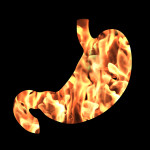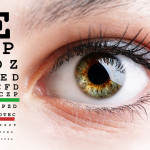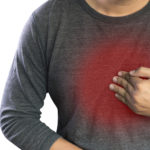By Bonnie Jenkins, Advanced Natural Medicine
The other night, I went out for a nice Italian dinner with my friend Lauren. As we ordered our pasta, she reached into her purse for her bottle of Nexium. Now Lauren is a great believer in modern medicine. And she raves about how well her little purple pill quenches the fire in her chest, allowing her to continue eating like she was a teenager.
Lauren had suffered form chronic heartburn for years. She thought her only options were to either put up with the pain or pop a handful of antacids daily. By the time she had it checked by her doctor, she had trouble swallowing and had actually damaged her esophagus. But instead of talking to Lauren about what and how she ate, the good doctor just whipped out his little pad and wrote a prescription for Nexium..
Lauren’s been happy with the results. And why not? After all, taking one little purple pill is a lot easier than changing your diet. But not treating the underlying cause of her heartburn opens up a whole host of potential problems – not the least of which is esophageal cancer.
Hurdy Gerdy
If you’ve seen any of the myriad of ads for heartburn medication (how could you miss them?), you know that ignoring chronic heartburn or acid reflux is a bad move. Acid reflux may be a sign that you have gastroesophageal reflux disease (GERD), a chronic condition that can eventually damage your esophagus.
When you eat, food travels down the esophagus until it reaches the lower esophageal sphincter (LES), a muscle that opens to permit food to enter the stomach and then closes back up to protect the esophagus from stomach acids. Heartburn occurs when the LES is weakened or doesn’t close properly. As a result, the stomach contents can squirt back up into the esophagus. And while the stomach is built to handle acid, the esophagus is not.
If your esophagus is irritated repeatedly, it may begin to erode and form ulcers in the lining of the esophagus. Chronic acid reflux can also cause a pre-cancerous condition called Barrett’s esophagus. Fortunately, only about 10 out of 100 people with GERD develop this cancer. But your risk depends on how long you’ve had symptoms and how frequently they appear.
MD Exposes the Hidden Danger to Your Eyes

When your eyesight starts to fail, it's a real problem. Suddenly you can't go to the grocery store... you can't get to the doctor if you have an emergency... you can't meet your friends for dinner…
Your "regular" doctor doesn't have time to keep up with the latest research. And the same goes for eye doctors. They go to school to learn how to fit you for glasses and contacts, but have no way of preventing the damage and loss of eyesight that threatens your freedom and independence.
Let me show you something that explains a LOT about how your eyes work.
In my FREE Special Report, I'll show you a HUGE, untapped resource for your eyes that safely and naturally restores clear, effortless eyesight.
Click here to get started...
Certain foods, including chocolate, peppermint, onions, garlic and alcohol, can weaken or relax the LES. Others may irritate or even dissolve the esophagus’ protective mucous lining, including acidic foods, caffeinated beverages and hot peppers. If you suffer frequent heartburn, your digestive system might not tolerate even small amounts of these common culprits.
But it’s not just what you eat, but how much. Overeating can trigger GERD by causing the stomach to produce a glut of stomach acid. Overeating on a regular basis can also cause weight gain and excess body weight puts undue stress on the stomach. Some drugs, especially blood pressure and arthritis medications, can also exacerbate heartburn.
Soothe the Burn
Fortunately, Mother Nature has provided several natural ways to quickly ease the pain and discomfort of GERD. Popping a couple of deglycyrrhizinated licorice (DGL) tablets before meals not only helps to prevent heartburn, it’s reputed to soothe and heal the esophageal tissue by decreasing inflammation and ulceration. And unlike other forms of licorice, DGL is safe for people with high blood pressure. Most herbalists recommend taking 350 to 1,000 mg. three times a day with meals.
Adding other herbs like slippery elm, marshmallow root and plantain can boost the anti-inflammatory action of DGL, neutralize stomach acid and aid in healing the esophagus. An extra dose can also be used at the onset of symptoms or before bed, if needed.
Long-term Protection
If you suffer from chronic heartburn or have been diagnosed with GERD, it’s a good idea to make sure you’re getting enough zinc. According to a recent study by the National Institutes of Health, low levels of this critical mineral just might contribute to the development of esophagel cancer.
In their study, the NIH researchers looked at specimens from esophageal tissue biopsies collected from more than 130 Chinese participants. The specimens were assessed using a technique called X-ray fluorescence spectroscopy that can detect levels of specific nutrients. What they were looking for were the levels of key minerals that may play a role in the development of esophageal cancer, including copper, iron, sulfur and zinc.
The World's Quickest Solution for Ending Prostate and Urinary Misery
This has recently been revealed to be one of the only real breakthroughs in prostate health.
The seeds of a strange fruit (sometimes called "Chinese Apples") hold powerful phytonutrients that are a revolution in prostate health.
In fact, UCLA and Veterans Administration research have now proved this to be true.
Not only that, but it may be the worlds quickest solution for ending prostate misery.
Simply stated, these phytonutrients represent a huge step beyond beta sitosterol, saw palmetto, and other phytosterols alone.
Simply click HERE if you want to have fast prostate relief...restful, uninterrupted sleep...no more constant "urges to go"...enhanced virility...and optimal prostate support for life.
Over the course of the 16 year study, 60 of the participants developed esophageal cancer. When the researchers analyzed their mineral status they found that these folks also had lower than average zinc levels. On the flip side, the subjects with the highest levels of zinc were nearly 80 percent less likely to develop esophageal cancer.
Earlier animal studies by the NIH show that replenishing zinc through diet lowers the risk of esophageal cancer by triggering cell death in esophageal epithelial cells. Foods natually high in zinc include beef, pork, lamb, seafood an dairy products. What if you don’t eat meat? Vegetarian sources include beans, lentils, tofu, nuts, seeds and wholegrain cereals. And one classic Fall food, pumpkin seeds, provides one of the most concentrated vegetarian sources of zinc.
You can also increase your zinc intake by taking a multivitamin that includes at least 15 mg. of zinc. If you do suffer from a deficiency, higher levels (up to 50 mg. taken three times per day) may be called for. But before you take it upon yourself to megadose on zinc, talk with your doctor since high doses may cause a zinc-induced copper deficiency.
One Last Thing …
Because every person is unique, it’s important to track your body’s reactions to particular foods. If you suffer from chronic heartburn, try writing down everything you eat for a week or two, then circle the things that cause pain or discomfort. Be sure to include food quantities since you may find that 8 ounces of orange juice causes no symptoms, but 10 ounces induces pain.
Certain foods contain compounds that help reduce reflux risk. For example, low-acid papaya boasts papain, an enzyme that aids digestion. Other low-acid foods include ripe bananas, peaches, figs, cherries and cantaloupe. Salmon, avocado and yogurt contain pantothenic acid, a helpful B vitamin. And ginger, chamomile or lemon balm tea can often ease the symptoms of GERD.
This Just In …
If lung-cancer runs in your family, a new study from the International Agency for Cancer Research just might help you hedge your bets against this killer disease. According to their findings, cabbage, broccoli and other cruciferous veggies can offer protection in people with a specific genetic makeup that makes them vulnerable to lung cancer.
In the study, the researchers recruited 2,141 patients with lung cancer and 2,168 healthy controls from six countries in eastern and central Europe. Each of the participants filled out a food and had their genetic status assessed from a blood sample. The IACR researchers were especially interested in two genes known as GSTM1 and GSTT1. When these two genes are inactive or don’t “turn-on” properly, the risk of developing lung cancer increases.
After analyzing the data, they found that the patients with an inactive form of the GSTM1 gene who ate cruciferous vegetables at least once a week had 33 percent more protection against lung cancer. The people who had an inactive GSTT1 gene had a 37 percent increase in protection. And those who had both genes inactivated experienced a 72 percent protective effect just by eating these healthy vegetables on a regular basis.
Even if you aren’t predisposed to lung cancer, cruciferous vegetables can help to ward off other types of cancer. Clinical trials show that regularly eating these tasty veggies can thwart tumors implicated in the development of breast, endometrial, colon and liver cancer. And, since these foods are in season and widely available, there’s no excuse not to include them in your meals. So, whether you steam them, sauté them or eat them raw, make sure you are getting at least two to three servings of the healthy cruciferous crew every week.
References:
Abnet CC, Lai B, Qiao YL, et al. “Zinc concentration in esophageal biopsy specimens measured by x-ray fluorescence and esophageal cancer risk.” Journal of the National Cancer Institute. 2005;97:301-306.
“Cabbage fans less likely to develop lung cancer, suggests study.” NutraIngredients.com. 28 Oct 2005.
Fong LY, Nguyen VT, Farber JL. “Esophageal cancer prevention in zinc-deficient rats: rapid induction of apoptosis by replenishing zinc.” Journal of the National Cancer Institute. 2001; 93:1525-1533.
“Glycyrrhiza glabra – monograph.” Alternative Medicine Review. 2005;10:230-237.






